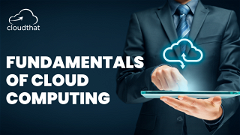Fundamentals of Cloud Computing
Fundamentals of Cloud Computing is for anyone with an IT background who is interested in understanding what is Cloud Computing. It will equip you with basic knowledge of Cloud Technologies in use now....
- All levels
- English
Course Description
Fundamentals of Cloud Computing is for anyone with an IT background who is interested in understanding what is Cloud Computing. It will equip you with basic knowledge of Cloud Technologies in use now. This course provides a comprehensive introduction to the fundamental concepts of cloud computing. Participants will gain an understanding of the principles, architectures, and services associated...
Fundamentals of Cloud Computing is for anyone with an IT background who is interested in understanding what is Cloud Computing. It will equip you with basic knowledge of Cloud Technologies in use now. This course provides a comprehensive introduction to the fundamental concepts of cloud computing. Participants will gain an understanding of the principles, architectures, and services associated with cloud computing, along with practical insights into its applications and benefits.
What you’ll learn
- Introduction
- Evolution of Software
- Traditional IT Infrastructure
- Exercise
- Cloud Infrastructure
- Key attributes of cloud computing
- Cloud Advantages: Scaling and Redundancy
- Cloud Segments
- Cloud Deployment Models
- Popular cloud companies, services and products
- Cloud Use Cases
- Cloud Security
- Conclusion
Covering Topics
Advantages of services
Why cloud matters
Job Predictions
Mainframes
Post PC Era
Traditional IT Infrastructure Main Issues
IT Infrastructure Pyramid of Effort
Software Testing
Project Management
Cloud Applications
Cloud Benefits
Examples of Cloud Advantage
Flexibility Vs Responsibility
Public and Private Cloud
Hardware and Software Virtualization
Hardware and Software Virtualization
How analytics companies use the cloud
Cloud services security controls
Security and privacy
Curriculum
Frequently Asked Questions
This course includes
- Lectures 13
- Month 1 Month
- Language English
- Certificate No

